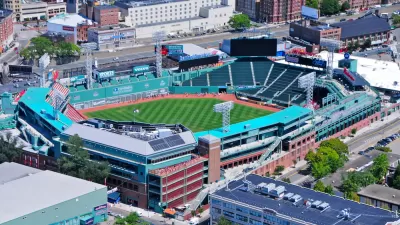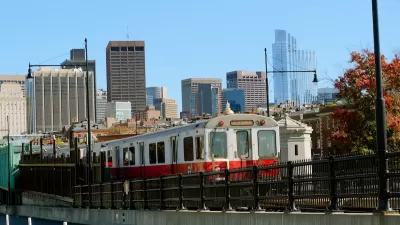Anthony Flint reflects on the story of economic development and historic preservation that led to the saving of Boston's historic Fenway Park from demolition in the 1990s.
Flint discusses the confluence of factors (aging infrastructure, need for more seats and revenue) leading to calls for the historic treasure's demolition, various plans for replacements, and the heroic effort to save the ballpark.
"Today Fenway Park has the Monster Seats and hand-crafted ales and delicious clam chowder, expanded and more comfortable seating all around, the ubiquitous luxury boxes uniquely close to the action. Watching a game at Fenway Park is an experience unlike any other."
However, there's a downside to this treasured experience, its "increasingly out of reach for middle-class families."
"It's hard to say how much the cost of all the renovations and improvements at a 100-year-old facility factors into this – the major cost being the payroll for the players – and harder still to imagine that a brand new ballpark wouldn't trigger this same kind of impact on fans. But historic preservation is always costly."
For most Bostonians, I'm guessing, the price to preserve this unique historical experience is plenty worth it.
FULL STORY: As Fenway Park Turns 100, Remember That It Almost Didn't Make It

Trump Administration Could Effectively End Housing Voucher Program
Federal officials are eyeing major cuts to the Section 8 program that helps millions of low-income households pay rent.

Planetizen Federal Action Tracker
A weekly monitor of how Trump’s orders and actions are impacting planners and planning in America.

The 120 Year Old Tiny Home Villages That Sheltered San Francisco’s Earthquake Refugees
More than a century ago, San Francisco mobilized to house thousands of residents displaced by the 1906 earthquake. Could their strategy offer a model for the present?

HSR Reaches Key Settlement in Northern California City
The state’s high-speed rail authority reached an agreement with Millbrae, a key city on the train’s proposed route to San Francisco.

Washington State Legislature Passes Parking Reform Bill
A bill that would limit parking requirements for new developments is headed to the governor’s desk.

Missouri Law Would Ban Protections for Housing Voucher Users
A state law seeks to overturn source-of-income discrimination bans passed by several Missouri cities.
Urban Design for Planners 1: Software Tools
This six-course series explores essential urban design concepts using open source software and equips planners with the tools they need to participate fully in the urban design process.
Planning for Universal Design
Learn the tools for implementing Universal Design in planning regulations.
Ada County Highway District
Clanton & Associates, Inc.
Jessamine County Fiscal Court
Institute for Housing and Urban Development Studies (IHS)
City of Grandview
Harvard GSD Executive Education
Toledo-Lucas County Plan Commissions
Salt Lake City
NYU Wagner Graduate School of Public Service





























